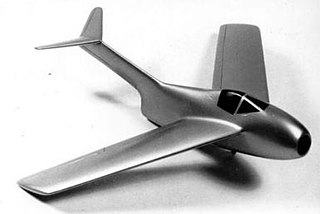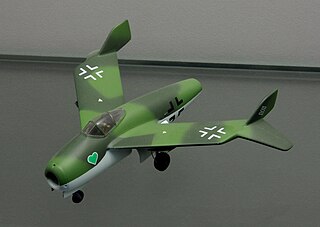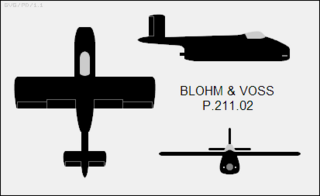Hamburger Flugzeugbau (HFB) was an aircraft manufacturer, located primarily in the Finkenwerder quarter of Hamburg, Germany. Established in 1933 as an offshoot of Blohm & Voss shipbuilders, it later became an operating division within its parent company and was known as Abteilung Flugzeugbau der Schiffswerft Blohm & Voss from 1937 until it ceased operation at the end of World War II. In the postwar period it was revived as an independent company under its original name and subsequently joined several consortia before being merged to form Messerschmitt-Bölkow-Blohm (MBB). It participates in the present day Airbus and European aerospace programs.

The Focke-Wulf Ta 183 Huckebein was a design for a jet-powered fighter aircraft intended as the successor to the Messerschmitt Me 262 and other day fighters in Luftwaffe service during World War II. It had been developed only to the extent of wind tunnel models when the war ended, but the basic design was further developed postwar in Argentina as the FMA IAe 33 Pulqui II. The name Huckebein is a reference to a trouble-making raven from an illustrated story in 1867 by Wilhelm Busch.

The Emergency Fighter Program was the program that resulted from a decision taken on July 3, 1944 by the Luftwaffe regarding the German aircraft manufacturing companies during the last year of the Third Reich.

Wunderwaffe is a German word meaning "wonder-weapon" and was a term assigned during World War II by Nazi Germany's propaganda ministry to some revolutionary "superweapons". Most of these weapons however remained prototypes, which either never reached the combat theater, or if they did, were too late or in too insignificant numbers to have a military effect. The V-weapons, which were developed earlier and saw considerable deployment, especially against London and Antwerp, trace back to the same pool of highly inventive armament concepts. In the German language, the term Wunderwaffe generally refers to a universal solution which solves all problems related to a particular issue, mostly used ironically for its illusionary nature.

The Heinkel HeS 011 or Heinkel-Hirth 109-011(HeS - Heinkel Strahltriebwerke) was an advanced World War II jet engine built by Heinkel-Hirth. It featured a unique compressor arrangement, starting with a low-compression impeller in the intake, followed by a "diagonal" stage similar to a centrifugal compressor, and then a three-stage axial compressor. Many of the German jet-powered aircraft designs at the end of the war were designed to use the HeS 011, but the HeS 011 engine was not ready for production before the war ended in Europe and only small numbers of prototypes were produced.

The Messerschmitt P.1101 was a single-seat, single-jet fighter project of World War II, developed as part of the 15 July 1944 Emergency Fighter Program which sought a second generation of jet fighters for the Third Reich. A prominent feature of the P.1101 prototype was that the sweep angle of the wings could be changed before flight, a feature further developed in later variable-sweep aircraft such as the Bell X-5 and Grumman XF10F Jaguar.
The Focke-Wulf Project I was a design study for a jet fighter, to be built in Germany during World War II. In 1942, the Reichsluftministerium (RLM) asked Professor Kurt Tank of the Focke-Wulf factory to investigate the possibility of a single-engine jet fighter. He was given the development plans of the BMW 003, Jumo 004 and Heinkel HeS 011 engines. Late in 1942 the Project Office, led by Ludwig Mittelhuber, began to work on a series of fighter projects, to be powered by one of these new turbojet units.

The Focke-Wulf Flitzer was a jet fighter under development in Germany at the end of World War II.

The Heinkel He P.1079 was a projected German V-tail all weather jet fighter designed by Heinkel Flugzeugwerke in the closing stages of World War II. The aircraft was only a design; it was not produced.

The Blohm & Voss P 212 was a proposed jet fighter designed by Blohm & Voss for the Emergency Fighter Program Luftwaffe design competition during the Second World War.

The Blohm & Voss P 211 was a design proposal submitted by Blohm & Voss to the Volksjäger jet fighter competition of the Luftwaffe Emergency Fighter Program towards the end of the Second World War.

The Blohm & Voss P 213 was a submission to the Miniaturjäger programme of the Luftwaffe Emergency Fighter Program towards the end of the Second World War. The Miniaturjäger was to be powered by a pulse jet but the programme was scrapped in December 1944.

The Heinkel P.1078 was a single seat interceptor developed for the Luftwaffe by Heinkel aircraft manufacturing company under the Emergency Fighter Program during the last years of the Third Reich.

The Focke-Wulf 1000x1000x1000, also known as Focke-Wulf Fw 239, was a twinjet bomber project for the Luftwaffe, designed by the Focke-Wulf aircraft manufacturing company during the last years of the Third Reich.

The Messerschmitt P.1110 was a design for a single-seat, high-altitude interceptor, prepared for the German Luftwaffe by the Messerschmitt aircraft manufacturing company, under the Emergency Fighter Program during the last months of World War II.
The Blohm & Voss P215 was an advanced jet night fighter project by Blohm & Voss during the Second World War. With a crew of three and twin jet engines, it featured a tailless swept-wing layout and heavy armament. An order for three prototypes was received just weeks before the war ended.
The Blohm & Voss P 209 was one of a series of single-engined jet fighter design studies. Under development in the latter half of 1944, when the single-engined jet fighter requirement was issued the P 209 was radically revised to meet the deadline but was not taken further by the RLM.
The Blohm & Voss Ae 607 was a jet-powered flying wing design drawn up by Blohm & Voss in 1945. Very little is known about it and its existence was only confirmed in 2017.













